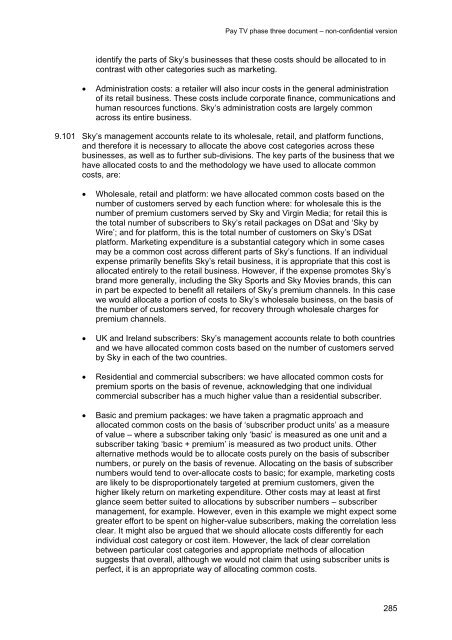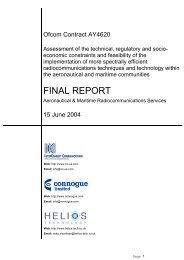Pay TV phase three document - Stakeholders - Ofcom
Pay TV phase three document - Stakeholders - Ofcom
Pay TV phase three document - Stakeholders - Ofcom
You also want an ePaper? Increase the reach of your titles
YUMPU automatically turns print PDFs into web optimized ePapers that Google loves.
<strong>Pay</strong> <strong>TV</strong> <strong>phase</strong> <strong>three</strong> <strong>document</strong> – non-confidential version<br />
identify the parts of Sky’s businesses that these costs should be allocated to in<br />
contrast with other categories such as marketing.<br />
� Administration costs: a retailer will also incur costs in the general administration<br />
of its retail business. These costs include corporate finance, communications and<br />
human resources functions. Sky’s administration costs are largely common<br />
across its entire business.<br />
9.101 Sky’s management accounts relate to its wholesale, retail, and platform functions,<br />
and therefore it is necessary to allocate the above cost categories across these<br />
businesses, as well as to further sub-divisions. The key parts of the business that we<br />
have allocated costs to and the methodology we have used to allocate common<br />
costs, are:<br />
� Wholesale, retail and platform: we have allocated common costs based on the<br />
number of customers served by each function where: for wholesale this is the<br />
number of premium customers served by Sky and Virgin Media; for retail this is<br />
the total number of subscribers to Sky’s retail packages on DSat and ‘Sky by<br />
Wire’; and for platform, this is the total number of customers on Sky’s DSat<br />
platform. Marketing expenditure is a substantial category which in some cases<br />
may be a common cost across different parts of Sky’s functions. If an individual<br />
expense primarily benefits Sky’s retail business, it is appropriate that this cost is<br />
allocated entirely to the retail business. However, if the expense promotes Sky’s<br />
brand more generally, including the Sky Sports and Sky Movies brands, this can<br />
in part be expected to benefit all retailers of Sky’s premium channels. In this case<br />
we would allocate a portion of costs to Sky’s wholesale business, on the basis of<br />
the number of customers served, for recovery through wholesale charges for<br />
premium channels.<br />
� UK and Ireland subscribers: Sky’s management accounts relate to both countries<br />
and we have allocated common costs based on the number of customers served<br />
by Sky in each of the two countries.<br />
� Residential and commercial subscribers: we have allocated common costs for<br />
premium sports on the basis of revenue, acknowledging that one individual<br />
commercial subscriber has a much higher value than a residential subscriber.<br />
� Basic and premium packages: we have taken a pragmatic approach and<br />
allocated common costs on the basis of ‘subscriber product units’ as a measure<br />
of value – where a subscriber taking only ‘basic’ is measured as one unit and a<br />
subscriber taking ‘basic + premium’ is measured as two product units. Other<br />
alternative methods would be to allocate costs purely on the basis of subscriber<br />
numbers, or purely on the basis of revenue. Allocating on the basis of subscriber<br />
numbers would tend to over-allocate costs to basic; for example, marketing costs<br />
are likely to be disproportionately targeted at premium customers, given the<br />
higher likely return on marketing expenditure. Other costs may at least at first<br />
glance seem better suited to allocations by subscriber numbers – subscriber<br />
management, for example. However, even in this example we might expect some<br />
greater effort to be spent on higher-value subscribers, making the correlation less<br />
clear. It might also be argued that we should allocate costs differently for each<br />
individual cost category or cost item. However, the lack of clear correlation<br />
between particular cost categories and appropriate methods of allocation<br />
suggests that overall, although we would not claim that using subscriber units is<br />
perfect, it is an appropriate way of allocating common costs.<br />
285
















